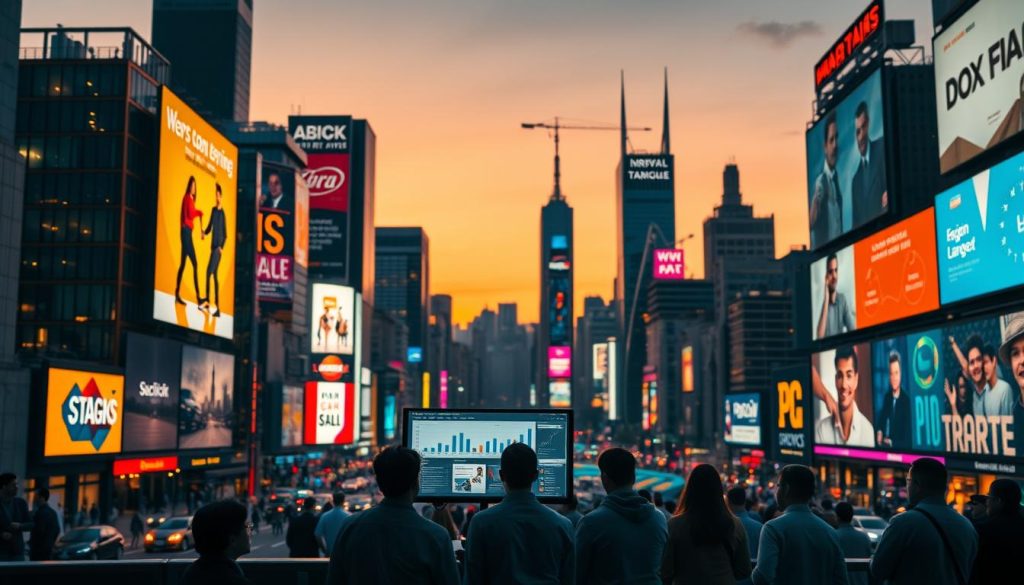Getting more website traffic is key for growing your online presence. Every business knows how important it is to bring visitors to their site. 61% of marketers say getting traffic and leads is their biggest challenge.
Improving your website’s traffic means more chances to meet new customers. Tools like Google Analytics and Search Console help find out which keywords draw in users. SEO tactics, such as optimizing title tags and meta descriptions, also play a big role in being seen.
It’s not just about how many visitors you get, but also the quality of those visits. Visitors who find your content useful are more likely to come back or make a purchase. SEO, social media, and email campaigns all help build this traffic.
Start by focusing on keywords that your audience is searching for. Even small changes, like making title tags shorter than 55 characters, can help more people click on your site. Every strategy here is designed to turn visitors into loyal customers.
Key Takeaways
- SEO drives 33% of major industries’ organic web traffic, making it a cornerstone for growth.
- Optimizing keywords and content quality reduces bounce rates and improves search rankings.
- Email marketing delivers a $36 return for every $1 spent, targeting niche audiences effectively.
- Mobile optimization is critical, as over half of web traffic now comes from smartphones.
- Quality content and backlinks from reputable sites boost authority and attract visitors.
Understanding Website Traffic and Why It Matters
Web traffic is key to online success. Each visit tells us about our audience’s actions. Knowing where your traffic sources come from helps you attract the right visitors.
“The first organic listing for a search term gets 39.8% of all clicks.” – Search Engine Land
Different Types of Web Traffic
Web traffic has five main traffic sources:
| Type | Description |
|---|---|
| Organic | Visitors arriving via search engines like Google. |
| Direct | Users typing your URL directly into their browser. |
| Referral | Visitors coming from other websites. |
| Social | Visitors from social media platforms like Facebook or Instagram. |
| Paid | Visitors from paid ads on search engines or social networks. |
How Traffic Impacts Business Goals
More organic traffic means better brand visibility and sales. Social media, worth $28.49 billion, drives engagement. SEO is vital as most users don’t go past the first page.
Video content can increase traffic by 80%. This shows the power of quality content.
Setting Realistic Traffic Targets
Begin with benchmarks. Use tools like Google Analytics to track metrics. Aim for quality over quantity.
Sites with growth-driven design see a 30–50% drop in bounce rates. Set monthly goals, like a 10% increase in organic traffic. Then, adjust based on results.
| Metric | Definition |
|---|---|
| Page views | Total pages viewed by visitors. |
| Unique visitors | Individual users visiting your site. |
| Bounce rate | % of visitors leaving after one page. |
| Avg. session duration | Time spent per visit. |
| Conversion rate | % of visitors taking desired actions. |
Optimizing Your Website for Search Engines (SEO)
SEO is key to getting more organic traffic. By following search engine rules, you can get higher rankings and improve user experience. Here’s how to do it well:
On-Page SEO Techniques
- Use primary keywords naturally in titles, headings, and content to signal topic relevance.
- Optimize meta descriptions to improve click-through rates and clarify page purpose.
- Ensure headers (H1-H6) follow a logical hierarchy for readability and search engine clarity.
Technical SEO Factors
Speed is important: sites that load in under 3 seconds rank better. Focus on:
- Compressing images to reduce load times.
- Implementing mobile-first design for responsive layouts.
- Adding schema markup to help search engines interpret content.
Link Building Strategies
Gain authority with backlinks from trusted sites. Good ways include:
- Creating shareable content to naturally earn links.
- Contacting industry blogs for guest posts with dofollow links.
- Repairing broken links on other sites by providing updated resources.
Local SEO Tactics for American Businesses
Improve local visibility by:
- Claiming and updating your Google Business Profile with accurate hours, photos, and reviews.
- Targeting location-based keywords like “auto repair in Austin” in content and directories.
- Encouraging customer reviews to improve local search rankings.
Every part, from page speed to local listings, helps drive traffic over time. Remember, SEO takes months to show results, but the benefits last.
Creating High-Quality Content That Drives Traffic
High-quality content is key to drive traffic and gain authority. Start with six proven formats: list posts, how-to guides, Q&As, success stories, product updates, and industry news. List posts, like “9 Instagram Tips,” and how-to articles, like “Run a Hashtag Contest,” draw readers with clear steps.
- List posts boost traffic through numbered structures.
- How-to guides establish expertise and guide users toward your services.
- Success stories (e.g., “How We Gained 282K Page Views”) showcase real results.
Companies that prioritize blogging see 13× the ROI compared to those that don’t.
Optimize headlines with numbers—posts starting with “7 Tips” or “5 Strategies” see a 73% higher click-through rate. Use visuals: articles with images boost engagement by 94%. Link internally to core content for better SEO. Email marketing drives traffic too—links in newsletters can yield up to 4,400% ROI.
Refresh evergreen content yearly to maintain relevance. Address audience pain points directly: content solving specific issues increases conversions by 50%. Mobile-optimized pages see 30% higher engagement. By combining these tactics, you can boost traffic and turn visitors into loyal followers.
Leveraging Social Media Platforms to Boost Traffic
Social media is a strong tool for traffic generation. With 3.96 billion users worldwide, sites like Instagram and TikTok are huge traffic sources
Choosing the Right Social Networks
First, figure out who your audience is. Instagram is great for brands with a visual appeal, thanks to its 130 million U.S. users. TikTok is perfect for those who love trends, with 1 billion users. Facebook, with 302 million U.S. users, is ideal for building a community.
Blackbird Baking Company grew a big fan base on Instagram before opening. This shows that starting small can lead to big boost traffic gains over time.
Creating Shareable Content
Video content gets people talking. TikTok campaigns, like DSW’s $2,000 investment that got 8 billion views, show the power of short videos. Use catchy thumbnails, emojis, and questions to get people to share your posts.
Adding relevant hashtags can also help more people find your content.
Social Media Advertising Options
Paid ads let you target specific groups. Spend your budget on platforms where your audience is most active. Try different ad types, like carousels or video pre-rolls, to see what works best.
Use tools like Google Analytics to see which platforms send the most visitors. This helps you make your ads even better.
Email Marketing Strategies to Generate Consistent Traffic
Email marketing is a powerful tool with over 4 billion users worldwide. It helps generate traffic and boost website traffic. Email campaigns can target specific traffic sources and control your message. Start by building a list that matches your goals.
Building an Effective Email List
Grow your list the right way with these tips:
- Give away free resources like guides or webinars to attract leads
- Make sure opt-in forms clearly state the value
- Divide your audience based on demographics or past purchases
Lists with segmented audiences tend to have 14.3% higher transaction rates. Focus on quality over quantity for better engagement.
Email Campaign Best Practices
Boost your impact with these strategies:
- Use personalized subject lines for a 20% higher open rate
- Make sure designs work well on mobile devices, as 69% of opens happen on mobile
- Place strong CTAs above the fold
Subject lines with ‘video’ can increase opens by 6%. Test different versions to find the best one.
Measuring Email Traffic Performance
Keep an eye on these key metrics to see how well you’re doing:
| Metric | Definition | Goal Range |
|---|---|---|
| Click-Through Rate (CTR) | % of recipients clicking links | 2-4% |
| Conversion Rate | Actions taken after clicking | 0.5-2% |
| Bounce Rate | Delivery failures | Less than 2% |
| RPR (Revenue Per Recipient) | Monetary value per recipient | Track via UTM parameters |
Automated emails, like those for abandoned carts, can increase revenue by up to 30x. Use Google Analytics to link email activity with website traffic.
Optimization Tips
Regularly clean your list to remove inactive users. Test subject lines and CTAs to find the best ones. Keep bounce rates below 2% for better deliverability. Use email heatmaps to improve design layouts.
Paid Advertising Methods to Increase Traffic
Paid advertising is a quick way to drive traffic to your site. You can use Google Ads and social media to target specific audiences. With 61% of marketers facing challenges, paid ads can help meet your goals fast.
61% of marketers state that their biggest challenge is generating traffic and leads.
Google Ads lets you bid on keywords people search for. First, find keywords that match your business. Then, use ads with optimized landing pages to boost your efforts. For instance, search ads show up when someone searches for “how to increase website traffic,” leading them to your site.

- Search Ads: Use Google Ads to reach users actively searching for your products.
- Social Media Ads: Facebook, Instagram, and LinkedIn let you target demographics, interests, or behaviors.
- Retargeting Ads: Show ads to visitors who left your site without converting.
Display ads on partner sites and native ads in articles also work. Retargeting campaigns can remind users about your brand, boosting conversions. Keep an eye on clicks and cost-per-click (CPC) to tweak your budget. Start small, test, and scale what succeeds.
- Set clear goals like drive traffic or boost sales.
- Allocate 10–20% of your budget to A/B test ad copies and audiences.
- Use analytics tools to measure traffic sources and adjust bids for high-performing ads.
Pair paid strategies with SEO for the best results. Paid ads give you quick visibility, while organic efforts build long-term success. A mix of both ensures steady growth without relying too much on one method.
Analyzing Your Traffic Sources and User Behavior
Knowing where your website traffic comes from is key for growth. Tools like Google Analytics and Search Console show patterns that guide your strategy.
“Data-driven insights are the compass guiding your website’s growth strategy.”
Essential Analytics Tools
Use these tools to track traffic sources:
- Google Analytics: Measures sessions, bounce rates, and conversion paths.
- Google Search Console: Identifies top search terms driving organic web traffic.
- Heatmap tools: Visualize where users click or scroll.
- Competitor analysis platforms: Compare your website traffic trends with industry benchmarks.
Key Metrics to Track
| Metric | Description | Why It Matters |
|---|---|---|
| Traffic Sources Breakdown | Showcases organic, referral, or direct visits. | Highlights top-performing channels. |
| Bounce Rate | % of visitors leaving after one page. | Reveals landing page effectiveness. |
| Session Duration | Average time spent on your site. | Longer durations signal engaging content. |
| Exit Pages | Pages where users leave your site. | Pinpoints problematic areas. |
Using Data to Refine Your Strategy
Turn insights into action:
- Optimize top-performing traffic sources for more conversions.
- Revise low-performing landing pages to reduce bounce rates.
- Test CTAs using A/B experiments based on user scroll depth data.
Keep analyzing metrics like average session length and exit rates to improve user experience. Adjust content and design based on where visitors drop off. Every click and scroll offers clues to boost engagement and web traffic.
Advanced Traffic Generation Techniques
Advanced strategies help boost traffic and generate traffic from new places. Start by guest posting on big sites like HubSpot. This tactic helped them reach millions every month. Your brand becomes seen as an expert, bringing in more visitors.
- Target blogs with engaged audiences
- Create evergreen content for long-term visibility
- Include backlinks to your site in bylines
Guest Posting and Collaborative Content
Work with industry leaders on joint projects. This can be research or roundups. It brings your brand to new people and makes you more credible. For instance, SEAT teamed up with Instagram influencers, increasing visibility by 40% among the young.
Influencer Partnerships
Find micro-influencers who match your audience. Make tutorials or reviews together. This way, influencers share your content, building trust and bringing in more visitors.
“80% of marketers see user-generated content as a traffic driver.”
Video Marketing Strategies
Make videos for YouTube with the right keywords. Put videos on blogs and social media to keep people around longer. Videos can generate traffic by up to 157% if they’re good for search engines. Use TikTok or LinkedIn for specific groups.
Send video links in email newsletters to get people to your site. Mix these methods for better traffic generation through different channels.
Common Obstacles to Traffic Growth and How to Overcome Them
Getting more website traffic growth can be tough. You might face slow sites, content that doesn’t match what people want, or lots of competition. Here are some ways to beat these challenges:
- Technical Barriers: Slow sites or designs that don’t work on phones scare people off. Use tools like Google’s PageSpeed Insights to find solutions. Make your site fast and easy to use on phones to attract more visitors.
- Content Gaps: Old or low-quality content doesn’t keep people coming back. Check your content regularly and update it to meet your audience’s needs. Good, fresh content is key to growing your website traffic.
- Market Saturation: In crowded areas, find a smaller niche or team up with influencers. Use SEO to find and rank for keywords that others miss.
- Resource Limits: Tight budgets? Focus on big wins like email campaigns or social media. Working with smaller influencers can also be cost-effective.
“Adaptive strategies like dynamic SEO audits can boost traffic flow by 25%.”
Studies show sites that regularly check and adjust their SEO can see a 30% increase in traffic. For instance, making your site load faster can cut down on people leaving quickly, just like how better roads help traffic flow. Keep an eye on your site’s speed and how often people leave by checking these metrics weekly. Small, steady actions like updating content or testing different versions of pages can add up over time. Every problem has a solution—start solving yours today.
Conclusion: Building a Sustainable Traffic Strategy for Long-Term Success
Your traffic strategy needs to balance today’s actions with tomorrow’s goals. Focus on organic traffic by creating quality content. This approach ensures steady growth.
Choose topics that will always be relevant to your audience. Search engines like Google value content that shows you know your stuff. This is key for ranking well.
Being consistent is important. Businesses that plan their content well see more traffic over time. Start by checking how your SEO, social media, email, and ads are doing. Use analytics to spot what’s not working and make changes.
Having different ways to reach people helps you avoid problems when things change.
Start with small steps. Update old pages to boost your SEO. Share timeless guides or case studies on social media. Even small changes each week can make a big difference.
The aim is to create a system that grows with trends. Keep working on your strategy to keep growing your audience and sales over time.


